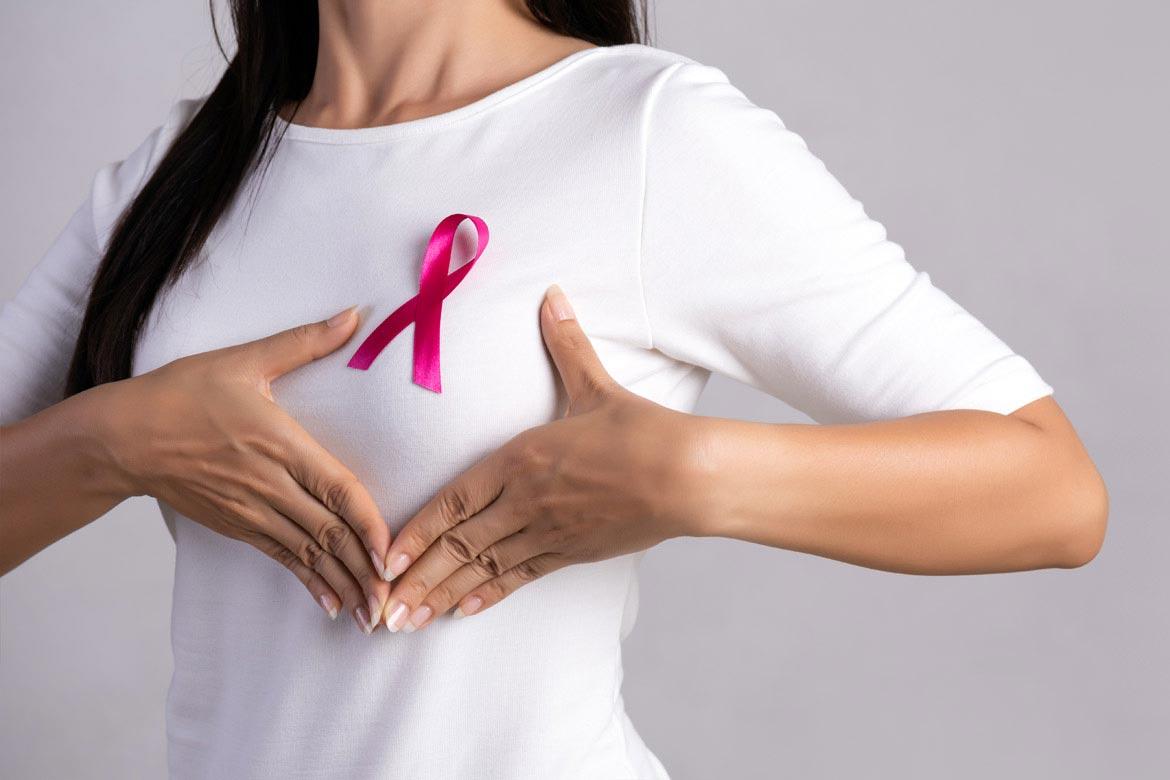What is a breast biopsy?
A breast biopsy is a procedure where a sample of cells or tissue is removed from an area in the breast for detailed analysis of the cells and their surrounding structures. It is typically recommended to confirm if an abnormality is cancerous or non-cancerous.
It can be used to:
- Assess a lump or thickening in the breast detected during a breast examination, or any other suspicious symptoms of breast cancer, such as bloody nipple discharge
- Investigate an abnormality seen on a mammogram, ultrasound, or other breast imaging tests, even in the absence of symptoms
Learn more about breast lumps and when a breast biopsy might be necessary.
Types of breast biopsies
A breast biopsy can be done in several ways. Types of breast biopsies include:
Fine needle aspiration biopsy
A very thin needle attached to a syringe is inserted into the abnormality to extract a sample of tissue or fluid for analysis.
Core needle biopsy
Similar to fine needle aspiration biopsy, this procedure uses a larger hollow needle to collect multiple samples at the same time. This is the most common type of biopsy used for diagnosing breast cancer.
Vacuum assisted biopsy (VAB)
Like the core needle biopsy, VAB uses a hollow needle but has additional vacuum suction to extract multiple samples. This procedure is more efficient. For small lumps, it is even able to completely remove it entirely.
Open surgical biopsy
An open surgical biopsy removes the entire lump or part of it for testing through a surgical incision or cut. Some of the surrounding normal breast tissue may be removed as well.
Some breast biopsies require the use of specialised guidance by tests like mammogram, ultrasound, CT scan or MRI in order to approach the area of abnormality more accurately. These methods are essential in cases where the abnormality is not palpable or cannot be felt:
Stereotactic mammogram-guided biopsy, which uses mammogram images done in a 3-dimensional field to pinpoint the location of the abnormality within the breast to guide needle insertion
Ultrasound-guided biopsy, which uses ultrasound images to locate the abnormality to guide needle insertion
MRI-guided biopsy, which uses detailed 3D pictures generated by magnetic resonance imaging to locate the abnormality to guide needle insertion
CT-guided biopsy, which uses a computerised tomography (CT) scanner to locate the abnormality to guide needle insertion
Why do you need a breast biopsy?
Your doctor may recommend a breast biopsy to investigate any abnormal findings detected during a routine breast examination. The breast biopsy can help determine whether cancerous cells are present, and if so, the origin and type of the cancer.
What are the risks and complications of a breast biopsy?
A breast biopsy is a relatively simple procedure with minimal risks. These include:
- Mild pain and bleeding
- Bruising and swelling
- Possible change in the appearance of the breast, depending on how much tissue was removed and how the wound heals.
Most of these side effects are temporary and subside with time.
How do you prepare for a breast biopsy?
Before scheduling a breast biopsy, let your doctor know if you are taking any blood-thinning medications (such as aspirin), or if you are pregnant or breastfeeding, so that your doctor can assess if it is safe for you to undergo the procedure.
On the day of the breast biopsy:
- Do not apply cream, lotion, powder, deodorant or perfume under your arm or around your chest.
- Wear a loose-fitting top that can be easily removed.
- You may have to fast for several hours before the procedure, depending on the procedure is done under local or general anaesthetic.
What can you expect in a breast biopsy?
A breast biopsy can be done in an outpatient setting in a doctor's office under local anaesthesia, or as a day surgery procedure under general anaesthesia.
Estimated duration
The procedure generally takes less than an hour. The duration depends on how many abnormalities are biopsied and the complexity of each procedure. For example, fine needle aspiration and core needle biopsies typically take less than 15 minutes while an open surgical biopsy can take up to an hour.
During the procedure
How the procedure is performed will depend on the type of biopsy that you are going for.
Generally, a radiologist or surgeon will sterilise your breast and inject a local anaesthetic to numb the area.
The lump within your breast will be located precisely with the help of an imaging device, such as a mammogram machine or ultrasound probe. The doctor will then insert the biopsy needle through the skin into the breast lump to retrieve samples of tissue.
After the procedure is completed, the incision will be closed with a compression dressing.
After the procedure
You should be able to return to normal daily activities after most biopsies. If you had a surgical biopsy, you may need to be monitored for a period of time before you can be safely discharged from hospital.
The results of your breast biopsy will be ready in 3 – 5 days.
Care and recovery after a breast biopsy
Mild pain and bruising are common after a breast biopsy. To relieve the discomfort, you should:
- Apply a cold pack to the biopsy site every 1 – 2 hours, which can help reduce swelling.
- Take pain relief medication as prescribed by your doctor.
- Refrain from strenuous activity.
Let your doctor know if you notice any significant or persistent breast swelling, bruising, redness or unusual discharge at the biopsy site. These could be signs of an infection that requires urgent treatment.








